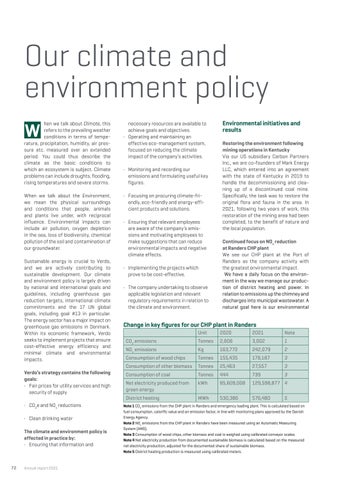Our climate and environment policy W
hen we talk about Climate, this refers to the prevailing weather conditions in terms of temperature, precipitation, humidity, air pressure etc. measured over an extended period. You could thus describe the climate as the basic conditions to which an ecosystem is subject. Climate problems can include droughts, flooding, rising temperatures and severe storms.
necessary resources are available to achieve goals and objectives. • Operating and maintaining an effective eco-management system, focused on reducing the climate impact of the company’s activities.
When we talk about the Environment, we mean the physical surroundings and conditions that people, animals and plants live under, with reciprocal influence. Environmental impacts can include air pollution, oxygen depletion in the sea, loss of biodiversity, chemical pollution of the soil and contamination of our groundwater.
• Focusing on procuring climate-friendly, eco-friendly and energy-efficient products and solutions.
Sustainable energy is crucial to Verdo, and we are actively contributing to sustainable development. Our climate and environment policy is largely driven by national and international goals and guidelines, including greenhouse gas reduction targets, international climate commitments and the 17 UN global goals, including goal #13 in particular. The energy sector has a major impact on greenhouse gas emissions in Denmark. Within its economic framework, Verdo seeks to implement projects that ensure cost-effective energy efficiency and minimal climate and environmental impacts. Verdo’s strategy contains the following goals: • Fair prices for utility services and high security of supply • CO2e and NOx reductions • Clean drinking water The climate and environment policy is effected in practice by: • Ensuring that information and
72
Annual report 2021
• Monitoring and recording our emissions and formulating useful key figures.
• Ensuring that relevant employees are aware of the company’s emissions and motivating employees to make suggestions that can reduce environmental impacts and negative climate effects. • Implementing the projects which prove to be cost-effective. • The company undertaking to observe applicable legislation and relevant regulatory requirements in relation to the climate and environment.
Environmental initiatives and results Restoring the environment following mining operations in Kentucky Via our US subsidiary Carbon Partners Inc., we are co-founders of Mark Energy LLC, which entered into an agreement with the state of Kentucky in 2019 to handle the decommissioning and cleaning up of a discontinued coal mine. Specifically, the task was to restore the original flora and fauna in the area. In 2021, following two years of work, this restoration of the mining area had been completed, to the benefit of nature and the local population. Continued focus on NOx reduction at Randers CHP plant We see our CHP plant at the Port of Randers as the company activity with the greatest environmental impact. We have a daily focus on the environment in the way we manage our production of district heating and power. In relation to emissions up the chimney and discharges into municipal wastewater. A natural goal here is our environmental
Change in key figures for our CHP plant in Randers Unit
2020
2021
Note
CO2 emissions
Tonnes
2,606
3,002
1
NOx emissions
Kg
163,772
242,079
2
Consumption of wood chips
Tonnes
155,435
179,187
3
Consumption of other biomass
Tonnes
25,463
27,557
3
Consumption of coal
Tonnes
444
739
3
Net electricity produced from green energy
kWh
85,609,008
129,598,877 4
District heating
MWh
530,386
576,480
5
Note 1 CO2 emissions from the CHP plant in Randers and emergency loading plant. This is calculated based on fuel consumption, calorific value and an emission factor, in line with monitoring plans approved by the Danish Energy Agency. Note 2 NOx emissions from the CHP plant in Randers have been measured using an Automatic Measuring System (AMS). Note 3 Consumption of wood chips, other biomass and coal is weighed using calibrated conveyor scales. Note 4 Net electricity production from documented sustainable biomass is calculated based on the measured net electricity production, adjusted for the documented share of sustainable biomass. Note 5 District heating production is measured using calibrated meters.
